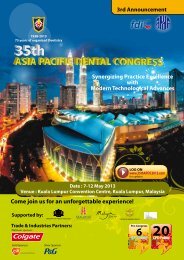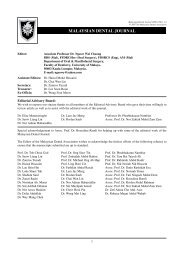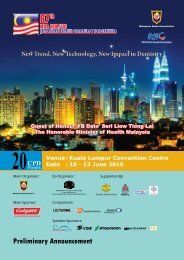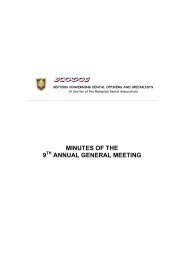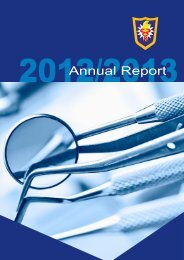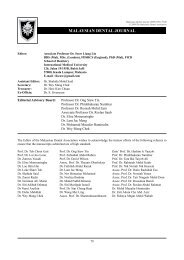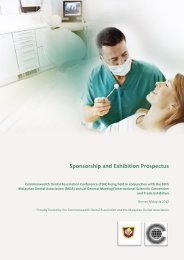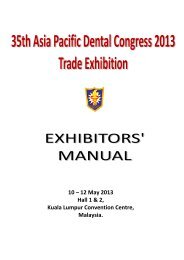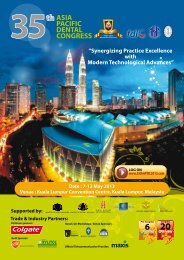PDF(6.5mb) - Malaysian Dental Association
PDF(6.5mb) - Malaysian Dental Association
PDF(6.5mb) - Malaysian Dental Association
- No tags were found...
You also want an ePaper? Increase the reach of your titles
YUMPU automatically turns print PDFs into web optimized ePapers that Google loves.
An Audit Of The Caseload And Waiting Time For Orthodontic Treatment In A University Settinginvestigate the amount of time patient has to wait before getting any orthodontic treatment has not been lookedinto especially in a university’s dental set-up.Thus, the aim of this study is to audit the amount and complexity of case load and the waiting time fororthodontic treatment in Orthodontic Department of UKM.MATERIAL AND METHODThis research was a retrospective study, conducted at Orthodontic Department of Universiti KebangsaanMalaysia (UKM). Referral pattern from year 2002 until 2007 was observed by recording the total number ofpatients in removable appliance (RA) and fixed appliance (FA) waiting list.In order to investigate the average waiting time in each waiting list, random sampling technique was usedin which every fifth patient in the waiting list were included into this study. Patient were excluded from this studyif :• Patient who did not respond at first call of appointment after screening.• Patient who postponed, denied or delayed the treatment voluntarily.• Patient who did not follow every stage of new patient flow for orthodontic treatment.Therefore, a total of 484 patients’ records which fulfilled the selection’s criteria were selected.From patient’s record, the demographic data of patient were recorded i.e. age and gender. The date of entryinto the waiting list were determined based on 3 main visits which are the ‘Klinik Rawatan Utama’(KRU) visit,screening visit and first visit for orthodontic treatment. Screening waiting time was calculated based on the timetaken from KRU to screening visit while time taken from screening to first visit for orthodontic treatment woulddetermined removable/fixed waiting time.The complexity of the referred cases were also graded according toComplexity Scale 5 as shown in Table 1.All the data collected were analysed descriptively using SPSS (Statistic Package for Social Science) version18.0. The decriptive data were presented in tables and line charts.Table 1: Complexity scale 5Complexity scaleCriteriaVery simpleSimpleModerateComplexVery complexExtractions only or a single removable appliance.More than one removable appliance required.Upper removable appliance with extra-oral anchorage/traction or single arch fixed appliance orupper and lower fixed appliances for alignment of Class I cases.Full fixed appliance in both arches for cases other than Class I but excluding cases defined as verycomplex. Treatment with functional appliance only.Full fixed appliance in both arches for all IOTN 5 cases or the additional difficulty that the caserequires interdisciplinary treatment or the additional involvement of a functional appliance.RESULTDemographic DataA total of 500 patients’ record involved in this study with 16 of them were excluded based on theexclusions criteria. 368 of the patients were female while the remaining 116 were male. The age of the patientsranges from 10 to 52 years old with mean of 21 ± 6 years old.Orthodontic case loadThere are two orthodontic treatment waiting lists i.e. the removable appliance (RA) and fixed appliance(FA) waiting lists.<strong>Malaysian</strong> <strong>Dental</strong> Journal Jan-Jun 2011 Vol 32 No 118



